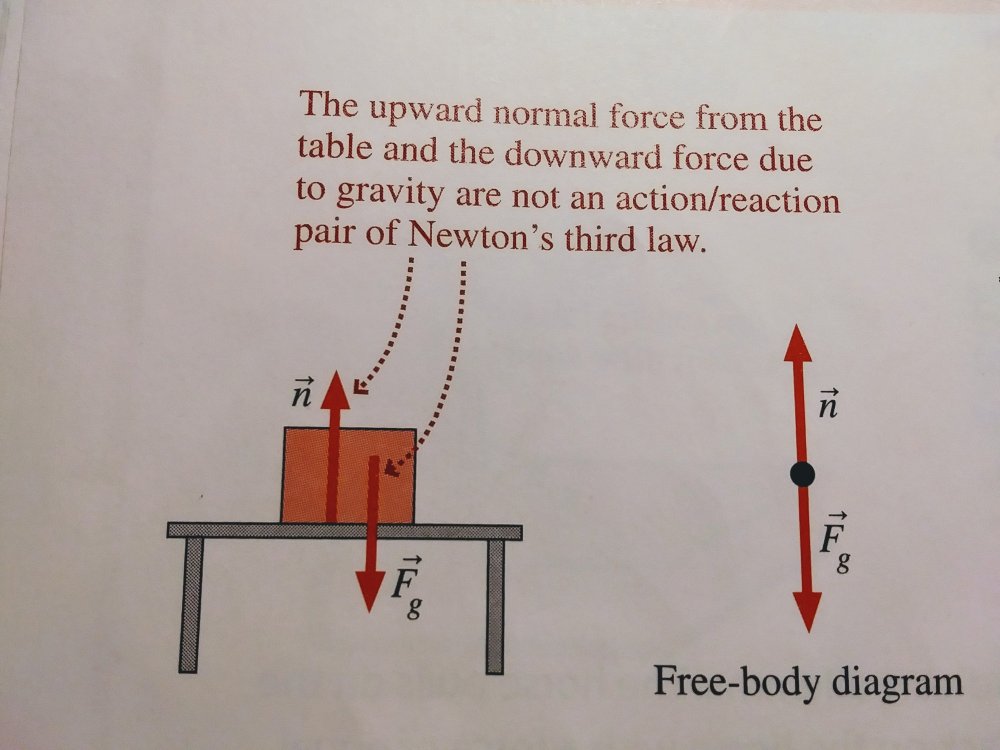

Nedcim
Senior Members-
Posts
67 -
Joined
-
Last visited
Content Type
Profiles
Forums
Events
Everything posted by Nedcim
-
-
I still have no clearer understanding why the example is not an an action-reaction pair of Newton's third law. The consensus is that Ghideon gave the best explanation but I don't see any distinction from the book's given definition: "If object A exerts a force on object B, then object B exerts an oppositely directed force of equal magnitude on A."
-
The physics book I'm using gives two examples where one is a third law pair and the other is not. What is the reasoning that this example is not a third law pair: "The upward normal force from the table and the downward force due to gravity are not an action/reaction pair of Newton's third law."
-
That's the issue. The pixels are missing from a portion of the output with the leading digit when 10 digits are displayed. That explains the discrepancy of the error showing in one expression and not another. Thanks to all who gave input.
-
The calculator is consistently wrong with certain expressions. 5.75/0.555 has the same issue where the leading digit is off by one. Yet the issue is not present with 5.38/0.343, 75.3/0.235 Or 47.83/82.94.
-
It's not an issue with memory. When the thousandths digit of the denominator is changed from 0 to 1, to approach sin40° the answer changes from the correct approximation of 6.14 to 5.13.
-
I found that my hand held calculator makes a computation error. I entered the expression (4sin80°)/sin40° and my calculator returned a value of ~ 5.13. I had previously entered the expression (4sin60°)/sin40° and my calculator returned a value of ~ 5.39 so I knew there was an error. I found the expression in error. I wanted to find where this error originated. I tried several iterations but still got the the same value. I approximated the the value of the numerator and denominator and that gave a correct approximation. I continued 3.93/0.640 gave a correct approximation of 6.13, but 3.93/0.641 returned a value of ~ 5.13 with same error as above. I never had a calculator make a computational error. I'm curious if anyone has experienced this issue and if this is a way to possibly correct it?
-
I have a class project and an idea I had deals with how people are influenced by outside factors beyond the given argument. I tested this idea with my partner for the project and generally we are in agreement about half the time which organizing data difficult. We used an online forum that is generally opinion based rather based on facts like this particular forum. My partner tends to agree with whoever has the most support from others in the forum. While I tend to agree whoever asks questions that are avoided. My partner and I both are influenced to varying degrees. I wondered if there was a way to eliminate this influence completely by using parameters and let a computer decide with a quantized output for each argument. I only have experience with Excel and Matlab this idea is probably too complicated to consider. Any suggestions?
-
I found a method using theorem of Pappus and any of the various volume of solids and checking that the volumes are equal.
-
In general a region bounded by the curve y=f(x) of a continuous single variable function, the x axis with some finite limits of integration. Let's work with a specific case. Suppose we have a region bounded by y=x^4, x=0 and x=1 with a centroid located at (5/6, 5/18). How do you prove that point is the centroid for the defined region?
-
Suppose you determine a point as the centroid for a single variable function is there a method to verify that the point is indeed the centroid?
-
Is there anything that can be seen or filmed that can pass through solid objects?
-
I want to use the data from the game in algorithm to output as a numerical display.That requires some type of onscreen reader that can convert the live game into data that can I can enter into any various programs.
-
I'm using the random game play of Tetris as a simplified approach to model more complicated systems. Instead of starting with zero rows of blocks, I start with nine rows as shown in the attached photo. Every game starts with a different degree of initial difficulty based on random starting position of each block and the placement of open spaces. I have a method for calculating this difficulty based on several factors. Each time a block falls and is put into position the difficultly level will change. I set ten sub-goals based when the difficulty level falls below a certain number. I want a numerical display to be able to track the time it takes to reach each sub-goal. I'm not sure how to enter the data from the game into a program to get an numerical output in real time. Any ideas?
-
Behavior is dependent on the structure. Why define anything by dependent factors? True. Wouldn't you also say that physics deals with the structure of matter? Citation? Anyhow the surface is still defined by the structure.
-
There are many fields in science that deal with form and structure. If the form and structure does not define what something is then what would you use to define it?
-
Factoring is allowed in the simplification of a function to compute the limit and that reduces the limit from an undefined to a product type. The property of infinity gives rules for the various products of infinity. All of that is unnecessary because it is understood that the fasting growing term will define the limits at infinity. Can you cite these difficult bits I'm avoiding?
-
Again, it's defined by the properties of infinity. It bypasses the undefined issue. Whatever term increases the fastest for large numbers is factored out and that results in a limit that as n approaches infinity results in infinity times 1 as the other terms approach 0. Another property of note is infinity to the power of infinity equals infinity. That shows unless infinity is redefined with a boundary then there is no point in asking what is beyond infinity. http://www.vitutor.com/calculus/limits/properties_infinity.html True, infinity is not a number.
-
Exactly. If the rule is applied incorrectly as shown above then it will be undefined. As I said earlier, the spacial properties of infinity applies: Infinity times infinity is infinity. [math]\mathop {\lim }\limits_{n \to \infty } \left( {{n} ({n-1}} \right)) = \infty[/math] Do you not guarantee that as n gets large so does the product of n and (n-1)?
-
What am I missing? Simply evaluate the limit: [math]\mathop {\lim }\limits_{n \to \infty } \left( {{n^2} - {n}} \right) = \infty[/math]
-
The equations are not necessary in violation with Newton' second law but simply cannot account for the additional factors.
-
Then your in disagreement with various texts and websites that apply that meaning: Why set up the limit to have an undefined subtraction of infinite limits? Simply, leave in the original form and factor n(n-1) then by the special properties of infinity, infinity times infinity=infinity. No.
-
That despite what you noted earlier a sequence that is divergent can in fact have a limit that is infinity. Are you in disagreement with that point and the cited link? Infinity. Infinity is a concept by definition that has no bounds, It's only in special hypotheses where the general rules of infinity are violated there can be any consideration of what is beyond infinity.
-
Yes in theory. Beyond particle matter, are there practical applications where mass energy equivalence has negligible significance? In the wave example, if there is a gain of mass during the wave cycle, then by the mass energy equivalence, there should be an equal loss of mass once the medium returns to an equilibrium state. No, Newton's Second Law only applies to rather large objects at least compared to those on the atomic scale. If atomic particles are involved then Schrödinger or Dirac equations applies depending on the particle speed.


